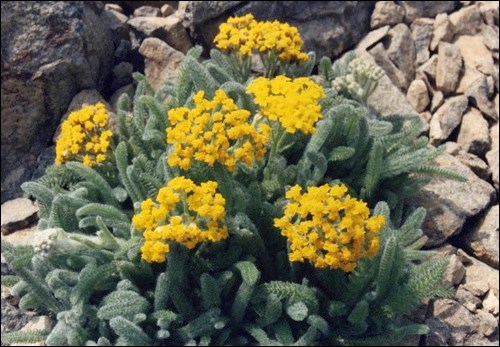Common yarrow (Achillea millefolium) has come a long way since the days when 'Cerise Queen' was considered the standard. But it was sure to disappoint with its floppiness, invasive habit and lacklustre colour. However, get ready to embrace recent introductions.
In general, yarrow has flat flower heads atop ferny, finely cut, aromatic dark green foliage. The cultivars range in height from 30 to 60 cm. While many of the older ones were rampant spreaders, the newer introductions are much better behaved: they're more upright, clump-like, less likely to overrun your borders, and come in striking colours.
Grow yarrow in full sun on well-drained soils. It's very drought tolerant once established. Do not fertilize or they will become floppy. Older varieties spread readily by rhizomes, needing judicious control (with a sharp spade!) within a border. Divide every three to four years. Deadhead for a neater appearance and more continuous bloom.
This long-?owering perennial can be used massed, as a tall ground cover, in the perennial border, and in fresh and dried arrangements. Bonus feature: is a butterfly nectar source.
Among the many cultivars are:
'Summer Pastels' - an All-America Selections winner - is available in pastel shades of pink, rose, apricot, cream, red, beige, purple or white.
'Paprika', with flowers of the same rich colour as the spice with yellow centres atop dark green foliage (60 cm/2 ft.), blooms from mid-summer to fall.
'Terracotta' is the colour of a terracotta clay pot, 75-90 cm (30-36 in.).
'Summer Berries', a new introduction, largely untested on the prairies but worthy of trial, resembles 'Summer Pastels' but with a blend of deeper, brighter, non-fading colours (60 cm/24 in. x 50cm/20 in.) with 8-12 cm/3-5 in. flower heads.
'Apricot Delight' is another newer, larger untested variety worthy of trial, with a compact form and pale apricot to near red flowers (30 x 30 cm).
'Fire King' is a deep carmine red, 50 to 60 cm (18-24 in.).
Sneezewort (Achillea ptarmica)
Sneezewort has graced prairie gardens for over a century. Its roots and leaves were once used as a cheap replacement for snuff (ptarmica is the Greek word for sneezing), thus the common name. Native to Europe and Asia and naturalized in North America, sneezewort is covered with hundreds of tiny, double, pure white ?owers in July and August on 45 to 60 cm (18 to 24 in.) stems. The foliage is fern-like and somewhat pungent.
Plant in full sun on poorer, well-drained soils. In richer soils they may become invasive. Divide every three to four years.
Sneezewort is useful in informal borders and for naturalizing as well as fresh and dried flower arrangements. Older varieties are 'The Pearl' and 'Perry's White'. Newer introductions include 'Angel's Breath' with large, double white flowers (50 x 60 cm/20 x 24 in.); 'Noblessa', a more compact, double white (30 x 40 cm/12 x 16 in.); and 'Ballerina', a "steady spreader" with a compact form and double flowers (30 x 45 cm/12 x 18 in.). All are a good substitute in floral arrangements for the noxious weed baby's-breath.
Dwarf woolly yarrow (Achillea tomentosa)
A low growing plant (15 to 20 cm/6 to 8 in.), woolly yarrow is ideal for hot, dry areas where the going is tough. Tomentosa, meaning hairy or woolly, refers to the foliage, which is aromatic, ?nely cut and a soft woolly grey. Flowers are yellow and produced in ?at clusters just above the foliage in June. The leaves form a dense mat.
Plant in full sun in well-drained soil on a hot, dry site.
Woolly yarrow is excellent as a ground cover, edging, for inter-planting among paving stones toward the edges of a walk or patio, or in a rock garden. It is easily mowed for a neater appearance or rejuvenation in midsummer after ?owering.
'Goldie' is a newer introduction with larger flowers. Achillea tomentosa var. Aurea has more intensely golden flowers.
Sara's most recent books are Gardening Naturally, the Chemical-free Handbook for the Prairies, the new and updated Creating the Prairie Xeriscape, and The Saskatoon Zoo & Forestry Farm, A Photographic History. She will be leading a garden tour to Spain this fall. For information, email [email protected]
Have a gardening question? Contact GardenLine, 306-966-5865 or [email protected]
This column is provided courtesy of the Saskatchewan Perennial Society (www.saskperennial.ca; [email protected]). Check out our Bulletin Board or Calendar for upcoming horticulture events (Labour&Learn at the Forestry Farm; garden tours; garden book launches).




